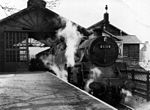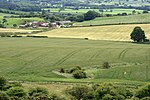Gisborough Priory is a ruined Augustinian priory in Guisborough in the current borough of Redcar and Cleveland, North Yorkshire, England. It was founded in 1119 as the Priory of St Mary by the Norman feudal magnate Robert de Brus, also an ancestor of the Scottish king, Robert the Bruce. It became one of the richest monastic foundations in England with grants from the crown and bequests from de Brus, other nobles and gentry and local people of more modest means. Much of the Romanesque Norman priory was destroyed in a fire in 1289. It was rebuilt in the Gothic style on a grander scale over the following century. Its remains are regarded as among the finest surviving examples of early Gothic architecture in England.The priory prospered until the Dissolution of the Monasteries in 1540, when it was abolished along with England's other monastic communities. The priory buildings were demolished and the stone re-used in other buildings in Guisborough. The east end of the priory church was left standing with its great window forming a distinctive arch, a well-known landmark used as a symbol for Guisborough. It became part of the estate of the Chaloner family, who acquired it in 1550. The east window was preserved by them as part of a Romantic vista adjoining their seat, Gisborough Hall, from which the priory takes its idiosyncratically spelled name. It is owned by the Chaloners but is in the care of English Heritage as a scheduled monument.Since the 19th century archaeological excavations have taken place in the priory grounds, though a substantial part of the site has not yet been investigated. In addition to the east window, surviving visible fragments of the complex include the lower courses of the west range, a vaulted undercroft, a gateway and a 14th-century dovecote still in use today. The adjoining Priory Gardens, laid out by the Chaloners in the 18th century, are under restoration by a volunteer group. The priory ruins and gardens are open to the public throughout the year.









